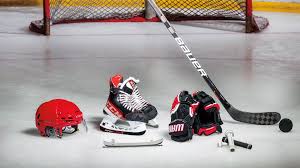
Hockey Sports Equipment
Hockey sports equipment consists of various parts. These include a hockey stick, a mouth guard and a goalie mask. These components are essential for the game. Moreover, they help the players to avoid getting injured. These pieces of hockey equipment are available in various sizes, so that they can be worn by players of all sizes.
Field hockey stick
A field hockey stick is a piece of equipment used for playing the sport. The stick has two main components. The first is the head, which is the vertical portion through which balls are shot. It is rounded at one end and flat on the other, allowing the player to shoot the ball accurately. The second part of the stick is the splice, which is the longer middle part.
The field hockey stick comes in a variety of styles and sizes. Traditional sticks are made of wood, but today they are made of lighter composite material. Some sticks even have high carbon content to provide extra power. In addition to sticks, field hockey balls are standard solid plastic balls, which are larger and slightly harder than baseballs. They are usually white, although other colours are acceptable if both teams agree.
Field hockey sticks are usually 89-95 cm long and weigh between 73 grams and 22 ounces. Although the traditional sticks were made of wood, modern sticks are made of composite materials, such as carbon fibre, aramid fibre, and fibreglass.
Goalie mask
A goalie mask protects the netminder’s face from hits and debris, and it is an essential piece of hockey sports equipment. The design of the goalie mask has evolved over the years, with the most recent versions being lightweight, protective, and comfortable. They also allow the goalie to express his or her personality, and many modern models are modeled after iconic goalie masks of the past.
Modern goalie masks are made from materials such as fiberglass, carbon fiber, and aramid fibers. These materials are better at absorbing high-impact shots. Most goalie masks are designed for adults, but there are some youth-style masks available that are designed for children.
Despite changes in design and function, goalie masks have remained a popular piece of hockey sports equipment. Manufacturers continue to refine and improve goalie masks and incorporate new materials, including carbon fiber and aramid fiber. These materials, along with aramid fiber and fiberglass, provide increased durability and impact resistance.
Knee pads
Knee pads for hockey are a vital part of a hockey player’s protective gear. These pads offer great protection and cushioning, and can also be comfortable to wear. They are lightweight and fit snugly over the knee. In addition, they allow for easy on and off, so players don’t have to undress in order to use the pads.
Knee pads are often made of a variety of materials. Some are made of neoprene, while others are made of cotton or spandex. Make sure to consider the material before you buy any type of knee pads. Generally, a polyurethane pad is the best choice for hockey knee protection. These are gel-like materials that are made to withstand shock without compromising flexibility. They also help to keep the player cool by drawing sweat away from the skin.
Knee pads are available for both women and men. Most are designed to protect against impact and injury, while others are specifically designed to prevent injury. If your knee is prone to injury, make sure you purchase knee pads that will protect it. Knee pads can help prevent future injuries and even help with rehabilitation after a game.
Mouth guards
Mouth guards are a key piece of hockey sports equipment, as they protect your teeth and gums from injury when you play. They also protect the cheek lining, tongue and lips. Teeth are especially vulnerable during sports, and mouthguards can reduce the chances of sustaining serious injuries or even concussions. One study of youth ice hockey players found that those who wore a mouthguard had a 64% lower risk of concussion. Even those who wore off-the-shelf mouthguards were effective in reducing the risk of concussions.
While mouth guards are not mandatory in the NHL, they are recommended for athletes who play ice hockey. While there are some debates about the effectiveness of mouth guards in reducing the risk of concussion, one study of 1,033 NHL players found that players who wore a mouth guard were 14% less likely to suffer concussions than players who didn’t wear a mouth guard. Furthermore, a study of NHL players’ concussion rates showed that players wearing a mouth guard reduced the severity of symptoms, when assessed using the modified McGill ACE symptom scale.
Mouth guards protect the teeth from damage caused by pucks that are shot from behind. They can reduce the chance of jaw, cheek, and tooth fractures, as well as chipped teeth. They also redistribute the force from puck hits and reduce the risk of oral injuries.


